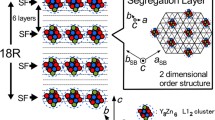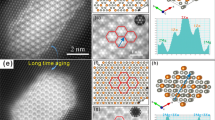Abstract
The strengthening mechanisms underlying the long period stacking order (LPSO) phases in Mg–Zn–Y alloys have largely remained unsolved due to unclear understanding of the local arrangements of Zn and Y atoms in the LPSO phases. The local arrangements of Zn and Y atoms in the LPSO structures are theoretically refined with first-principles method in this study. The calculations clearly demonstrate that Zn and Y atoms prefer clustering in the form of Zn6Y9 rather than arranging in random or ordered arrangements, or in the form of Zn6Y8 cluster, as proposed in previous experiments. The Zn6Y9 cluster, which leads to the formation of ABCA-type building block of the LPSO structures, can be particularly regarded as the ideal stoichiometric component of the LPSO structures. Various non-stoichiometric Zn m Y n (Mg) clusters derived from the Zn6Y9 cluster can also easily exist in the LPSO structures. The non-stoichiometric Zn m Y n (Mg) clusters may correspond to the arrangements of Zn and Y atoms in the LPSO phases with different Zn/Y ratios. This study indicates that the novel structures of the LPSO phases consisting of ABCA-type building blocks stem from the formation of the Zn6Y9 cluster and its derivative clusters, Zn m Y n (Mg).




Similar content being viewed by others
References
Inoue A, Kawamura Y, Matsushita M, Hayashi K, Koike J (2001) J Mater Res 16:1894
Abe E, Kawamura Y, Hayashi K, Inoue A (2002) Acta Mater 50:3845
Chino Y, Mabuchi M, Hagiwara S, Iwasaki H, Yamamoto A, Tsubakino H (2004) Scr Mater 51:711
Yoshimoto S, Yamasaki M, Kawamura Y (2006) Mater Trans 47:959
Hagihara K, Kinoshita A, Sugino Y et al (2010) Acta Mater 58:6282
Itoi T, Inazawa T, Kuroda Y, Yamasaki M, Kawamura Y, Hirohashi M (2010) Mater Lett 64:2277
Shao XH, Yang ZQ, Ma XL (2010) Acta Mater 58:4760
Oñorbe E, Garcés G, Pérez P, Adeva P (2012) J Mater Sci 47:1085. doi:10.1007/s10853-011-5899-4
Luo ZP, Zhang SQ (2000) J Mater Sci Lett 19:813
Matsuda M, Ii S, Kawamura Y, Ikuhara Y, Nishida M (2005) Mater Sci Eng A 393:269
Abe E, Ono A, Itoi T, Yamasaki M, Kawamura Y (2011) Phil Mag Lett 91:690
Itoi T, Seimiya T, Kawamura Y, Hirohashi M (2004) Scr Mater 51:107
Zhu YM, Weyland M, Morton AJ, Oh-Ishi K, Hono K, Nie JF (2009) Scr Mater 60:980
Zhu YM, Morton AJ, Nie JF (2010) Acta Mater 58:2936
Ping DH, Hono K, Kawamura Y, Inoue A (2002) Phil Mag Lett 82:543
Egusa D, Abe E (2012) Acta Mater 60:166
Soler JM, Artacho E, Gale JD et al (2002) J Phys Condens Matter 14:2745
Perdew JP, Burke K, Ernzerhof M (1996) Phys Rev Lett 77:3865
Troullier N, Martins JL (1991) Phys Rev B 43:1993
http://www.cohp.de/. Accessed 30 May 2012
Acknowledgements
The authors are grateful to Prof. Hengqiang Ye for stimulating discussions and to the reviewer for his insightful comments on the work. The authors also wish to gratefully acknowledge financial support from the National Natural Sciences Foundation of China (Nos. 51071149, 11244001, and 51222212), the National Basic Research Program of China (No. 2011CB606403), and CAEP foundation (Grant No. 2012B0302052). The computational support from the Informalization Construction Project of Chinese Academy of Sciences during the 11th Five-Year Plan Period (No. INFO-115-B01) is also highly acknowledged. And last but not least, the authors would like to acknowledge Prof. Medlin and Masters for their kind help on the revisions..
Author information
Authors and Affiliations
Corresponding author
Rights and permissions
About this article
Cite this article
Ma, SY., Liu, LM. & Wang, SQ. The predominant role of Zn6Y9 cluster in the long period stacking order structures of Mg–Zn–Y alloys: a first-principles study. J Mater Sci 48, 1407–1412 (2013). https://doi.org/10.1007/s10853-012-6890-4
Received:
Accepted:
Published:
Issue Date:
DOI: https://doi.org/10.1007/s10853-012-6890-4




